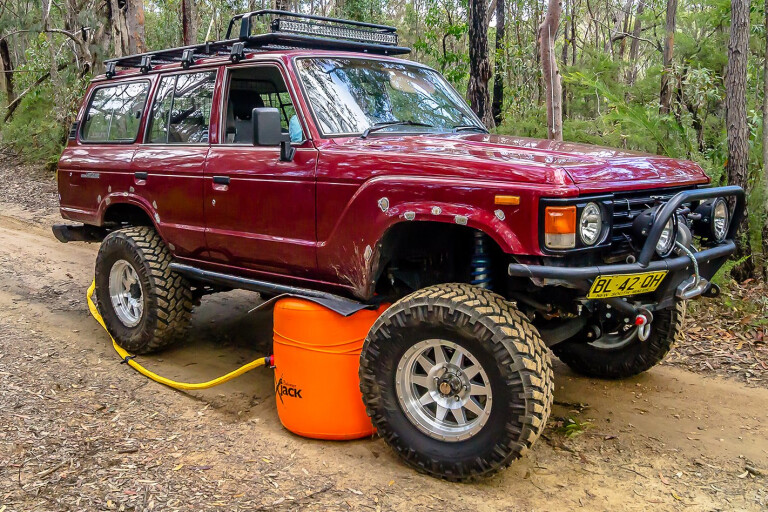
WHEN you’re in the bush, things go wrong – it’s essentially the reason why we’re running this recovery series.
And one of the most dangerous things you’ll ever come across is the simple act of lifting your four-wheel drive off the ground. In theory it’s a simple exercise and, in a road-going vehicle, requires such little brain capacity it could be measured in teaspoons. But when you’re dealing with lifted 4x4s, things get a little more complicated.
4x4s by their very nature are higher than most other vehicles, and when you start adding suspension lifts and larger tyres they soon reach heights that no bottle jack could ever hope to reach.
When you do get them off the ground they’re so unstable a stray breeze could see them come crashing down – not good news for any unsuspecting legs that happen to be underneath. Enter the exhaust jack.
 Exhaust jacks are designed as a simple and safe replacement for the trusty high-lift jack, a means to get your 4x4 off the ground without the risk of breaking your jaw with a wayward jack handle. Another plus is that an exhaust jack has a much larger, sturdier base.
Exhaust jacks are designed as a simple and safe replacement for the trusty high-lift jack, a means to get your 4x4 off the ground without the risk of breaking your jaw with a wayward jack handle. Another plus is that an exhaust jack has a much larger, sturdier base.
The jacks can get you out of sand or mud in a recovery situation, or lift a flat tyre off the ground. Plus they’re touted as being one of the simplest bits of recovery gear money can buy.
STEP 1: Secure the vehicle
IN ANY recovery situation it’s vital to plan out what’s going to happen through every stage of the process. 4x4s have a tendency to start moving once you’ve removed them from whatever is holding them back. Ensure the wheels staying on the ground are chocked, the handbrake’s on, and the vehicle is in gear. If the section of track you’re stuck on is steep enough, it’s a good idea to run a winch line to prevent the 4x4 from heading downhill at a rate of knots with no one behind the wheel.
STEP 2: A quick inspection
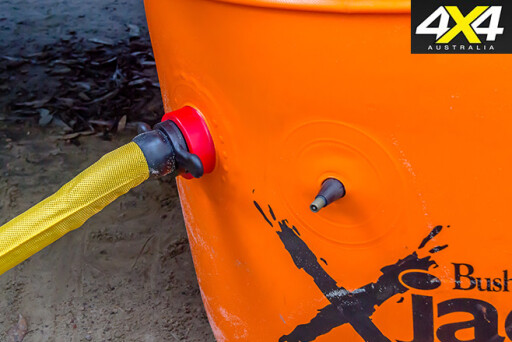 OVER time things are likely to get damaged through misuse, poor storage conditions, or wear and tear. Before attempting to lift your 4x4, give the jack and all hoses a thorough inspection. Keep an eye out for signs of abrasion, cuts, seams splitting, or bag deformation. While they may seem minor, even a small surface cut can become a point of failure once the weight of your 4x4 is sitting on it. If possible, inflate the bag off to the side for a thorough inspection before performing the lift.
OVER time things are likely to get damaged through misuse, poor storage conditions, or wear and tear. Before attempting to lift your 4x4, give the jack and all hoses a thorough inspection. Keep an eye out for signs of abrasion, cuts, seams splitting, or bag deformation. While they may seem minor, even a small surface cut can become a point of failure once the weight of your 4x4 is sitting on it. If possible, inflate the bag off to the side for a thorough inspection before performing the lift.
STEP 3: Prepare the jac
WHEN you’re confident the jack is safe to use, it’s time to set up all the components you’ll need. Additional to the bag itself, there should be at least one heavy-duty mat to protect the bag from punctures and cuts. Most common hose arrangements will consist of two pieces: one with an exhaust bung or funnel on one end and a one-way valve on the other, and another that connects the valve to the bag. Before installing the hoses, ensure all dirt and debris is clear of the connections.
STEP 4: Into position
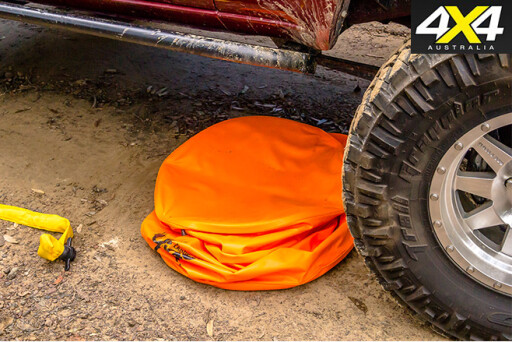 WITH the hoses connected, the next step is to position the jack itself. You’ll want it flattened as much as possible to ensure an even lift. If lifting a rear wheel, you need to position the bag under the chassis or rock slider just in front of the wheel. Front wheels will be the same, but behind the wheel. In either case, ensure it’s in a location that can support the full weight of the vehicle without causing damage to fuel tanks, lines, or the jack itself.
WITH the hoses connected, the next step is to position the jack itself. You’ll want it flattened as much as possible to ensure an even lift. If lifting a rear wheel, you need to position the bag under the chassis or rock slider just in front of the wheel. Front wheels will be the same, but behind the wheel. In either case, ensure it’s in a location that can support the full weight of the vehicle without causing damage to fuel tanks, lines, or the jack itself.
STEP 5: Begin lifting
When you’re happy with the bag position and confident the 4x4 won’t roll away when lifted, bump the gearstick into neutral and start the engine. The 4x4 should be void of passengers, with only the operator in the immediate area controlling the ignition through an open window. Keep the revs low to ensure a slow and controlled lift. Adjusting the idle up will often blow the exhaust bung out rather than speed up the process. Cut the ignition when the bag makes contact with the chassis and double-check that it’s lifting evenly.
STEP 6: Off the ground
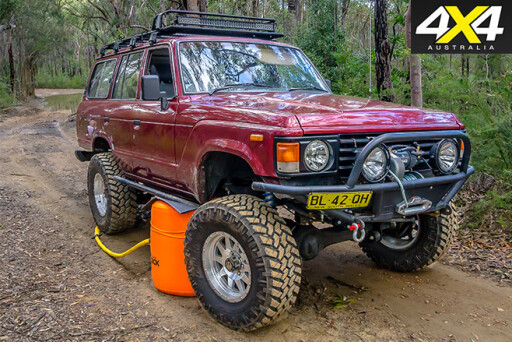 ONCE you’ve ascertained that the lift is going as planned, reach back into the 4x4 and re-start the engine. The jack will begin taking the weight of the 4x4, so it will require careful monitoring. Most exhaust jacks can lift around two tonnes but shouldn’t be filled with more than 10psi, so if the bag stops lifting the 4x4 or appears fully inflated, cut the engine again. The one-way valve in the hose will keep the bag inflated even with the engine off.
ONCE you’ve ascertained that the lift is going as planned, reach back into the 4x4 and re-start the engine. The jack will begin taking the weight of the 4x4, so it will require careful monitoring. Most exhaust jacks can lift around two tonnes but shouldn’t be filled with more than 10psi, so if the bag stops lifting the 4x4 or appears fully inflated, cut the engine again. The one-way valve in the hose will keep the bag inflated even with the engine off.
STEP 7: Safety first
IT SHOULD go without saying: Don’t ever trust a bag of hot air with your life. If you’re planning on working on the 4x4, position axle stands under the lifted corners to hold the weight. Alternatively, if you’re lifting a wheel to get it out of mud, snow or sand, now is the time to pack harder materials under the tyres.
STEP 8: Down she goes
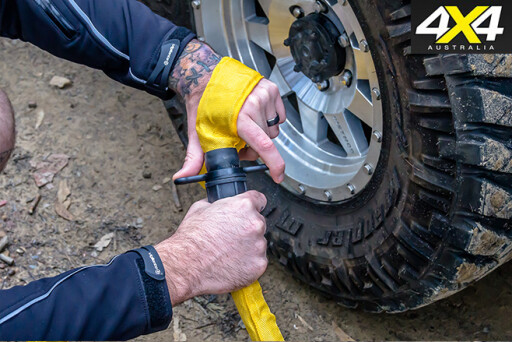 WHAT goes up must come down. And just as lifting your 4x4 should be a slow and controlled process, the same goes when dropping it. In the hose you’ll have a one-way valve that allows gases to travel into the jack, but not back out. Grab the valve and slowly twist it open to deflate the jack. You’ll want to crack it just enough that if the vehicle begins lowering in an unsafe manner you can quickly stop the flow of gases and halt the descent.
WHAT goes up must come down. And just as lifting your 4x4 should be a slow and controlled process, the same goes when dropping it. In the hose you’ll have a one-way valve that allows gases to travel into the jack, but not back out. Grab the valve and slowly twist it open to deflate the jack. You’ll want to crack it just enough that if the vehicle begins lowering in an unsafe manner you can quickly stop the flow of gases and halt the descent.
STEP 9: Back on solid ground
WITH the vehicle back on solid ground, give the jack another thorough visual inspection before packing it away. Keep an eye out for any new damage and clean off any mud or debris it may have collected. Over time, even a small patch of mud can dry out, rubbing the material and weakening the bag in the process. When back home, give the jack a thorough wash with warm water before leaving to dry out of direct sunlight.
TIPS FOR SAFER LIFTING
1. JACKS are designed for lifting, not holding. If you want to swing your legs under your 4x4, ensure it’s sitting on a stand, not a bag of hot air.
2. Unless your idea of a fun weekend is a lungful of exhaust gas, you’ll need to be careful both inflating and deflating the jack.
3. Things can go pear-shaped when performing any recovery. Keep everyone out of the 4x4 and the immediate areas, especially if working on a hill.
4. Despite their ability to lift massive weight, exhaust jacks will rarely handle more than 10psi.
5. 4x4s can and will fall off jacks, no matter what they’re made of. If you’re lifting a 4x4, it needs to be chocked.

COMMENTS